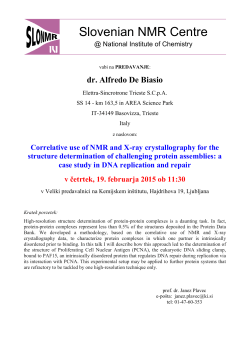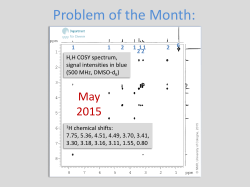
Janez Stepišnik , Aleš Mohorič , Igor Serša , Carlos Mattea
MICRO-RHEOLOGY BY NMR: Unveiling the non-Newtonian properties of liquids by MGSE spectroscopy Janez 1 Stepišnik , 1 University Aleš 1 Mohorič , Igor 1 Serša , Carlos 2 Mattea , 2 Stapf Siegfried of Ljubljana, FMF, Institute „Jožef Stefan“, Ljubljana, Slovenia, and 2 Technical Viscosity spectra of fluids Passive micro-rheology Micro-rheology is a technique used to measure the rheological properties of a medium, such as microviscosity, via the measurement of the trajectory of a flow tracer. Passive micro-rheology uses the thermal energy (kT) to move the tracers, which trajectories are measured optically either by microscopy or by diffusing-wave spectroscopy in order to yield the viscosity according to the generalized EinsteinSmoluchowsky relation1 and Franci 1,2 Bajd University, Ilmenau, Germany Measuring system-NMR mouse VAS of a variety of liquids and their mixtures was measured to get the viscosity spectra according to formula h(w)=h0 D(0)/D(w), in which h0 is declared fluid viscosity: Glycerol 26oC 1 Re (w ) = D(w ), kT which links the mobility spectrum and the velocity autocorrelation spectrum (VAS) D(w ) = v x (t )v x (0 ) cos(w t ) dt . Newtonian 0 Modulated gradient spin-echo Water T= 24oC echo2,3 The NMR method of modulated gradient spin (MGSE) is a tool of magnetic resonance, which provides VAS directly by modulating the phase of spin bearing particles in the inhomogeneous magnetic field. By taking into account Stokes law Newtonian 50 v% glycerol/water mixture T= 24oC 1 = , 6p r h the MGSE method provides also the viscosity spectrum according to 1 D(w ) ~ . h (w ) Toluene T=24oC Ethanol T=24oC CPMG train of p-radiofrequency (RF) pulses applied together with the fixed gradient, G, VAS of water/glycerol mixures measured by using two different NMR devices which periodically modulates the spin phases discordance, is MGSE technique that gives the spin echo decay, References 3.5 Volume fraction 100 MHz NMR G.t =const Gmax=5.9 T/m 3.0 75 H2 0 33 H2 0 80 H2 0 50 H2 0 66 H2 0 2.0 1.5 D x10 9 m2 s 1 2.5 0 H2 0 NMR mouse 18.7 MHz G=21.7 T/m 1.0 0.5 0.0 in which the attenuation of N-th echo is t 8 G (w m ) = D(w m ) 2 2 t ; t = Nt . T2 p wm 2 www.PosterPresentations.com 2 4 6 8 kHz 2 Here, T2 is the spin relaxation, t is the spacing between RF-pulses and wm=p/t is the modulation frequency. By changing t we can obtain D(w) at different modulation frequencies. RESEARCH POSTER PRESENTATION DESIGN © 2012 0 Contact Janez Stepišnik, University of Ljubljana, FMF, Jadranska 19, 1000 Ljubljana, Slovenia, janez.stepisnik@fmf.uni-lj.si 10 [1] R. Kubo, The fluctuation-dissipation theorem, Rep. Prog. Phys. 29, 1966, 25584. [2] J. Stepišnik, Analysis of NMR selfdiffusion measurements by density matrix calculation, Physica 104B (1981) 350- 361. [3] P.T. Callaghan, J. Stepišnik, Generalized analysis of motion using magnetic field gradients, Advances in Magnetic and Optical Resonance ed. Waren S. Waren, Vol. 19, p. 324-397, (1996), Academic Press. [4] J. Stepišnik, S. Lasič, A. Mohorič, I. Serša, A. Sepe, Spectral characterization of diffusion in porous media by the modulated gradient spin echo with CPMG sequence, J. Magn. Reson., 182, 195-199 (2006). [5] J. Stepišnik, A. Mohorič, C. Mattea, S. Stapf, I. Serša, Velocity autocorrelation spectra in molten polymer measured by NMR modulated gradient spin-echo, EuroPhysics Letters, 106 (2014) 27007.
© Copyright 2025









